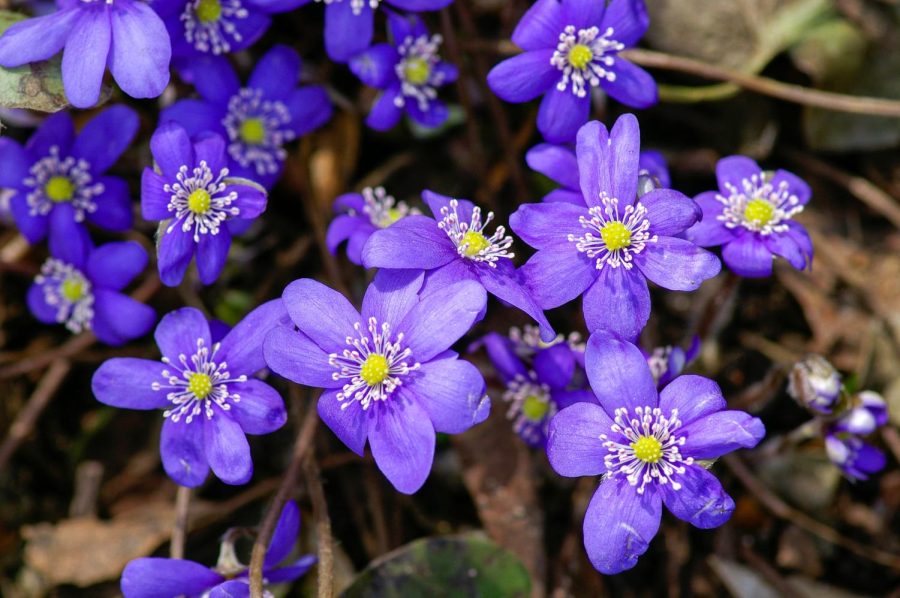Violets, Violets, Violets
March 25, 2022
If you know me at all, you know that I tend to listen to soothing music while I do almost anything. Going to school? There’s soothing music for that. Leaving the PAC parking lot after school? There’s soothing music for that. Working on a piece for English class? There’s soothing music for that. I tend to label anything from Bach to Del Rey under this category of “soothing”. What moved me to write this was a Lana Del Rey track, titled ‘Violets for Roses,’ which is among her newest work alongside the hit-single, “Arcadia”.
With that in mind, I was anxious to discover if violets are mentioned in other mainstream culture works—outside of Del Rey. To a high degree of astonishment, I found out that Shakespeare—yes, the William Shakespeare—was quite fascinated by violets. He referenced them in loads of his work, from A Midsummer’s Dream to Hamlet.
But we can’t forget art! Perhaps you’ve wondered why you rarely see the color violet in classical art. According to the studies and observations conducted by writer Allen Tager on behalf of the Journal of Cognitive and Culture, out of the 1300 artworks he observed (dating prior to 1863), only .06% contained the color. Tager credits the French Impressionist movement for the switch from purple to violet post-1863 and blames the expense and unavailability of the dyes that are required to produce violet for the under-usage. Violet was a product of a breakthrough in the world of art and continues to be often used today.
Much like most flowers have been assigned meanings—like roses (love) and hydrangeas (grace)—violets are also symbolic representing modesty. That is the dominating meaning behind the flower. It also has references to Christianity, from feminine domesticity to humbleness and virginity. Some, perhaps more subtle, themes include spiritual wisdom, faithfulness, and humility. Musically speaking, violets and their renowned color have been associated with sadder tones.
“Not going to lie, I don’t listen to much of Del Rey’s music,” added Arcadia High School (AHS) senior Michelle Huo, “but after reading her lyrics, it is not surprising that she uses color to add depth to her music. I mean, artists do it so much that there is an entire genre of music named after a color.”
Back in Shakespeare’s time, violets were utilized as treatments for things such as hemorrhoids, inflammation, and swelling—all effects that made the flower extremely desirable. Thus, the mania behind violets, along with their inclusion in the works of Shakespeare, made a breakthrough in the fields of literature and herbology.
According to critics from Genius, Del Rey’s choice to use flowers in her songs contribute to a pattern that she started since her debut album, Born to Die. In terms of the actual meaning behind the exchange, Octavio Lugo, the main critic through Genius’ explanation, believes that it has to do with the way that the flowers are handled—hint, do you remember what McDonough said about violets’ behavior?
“Violets are sometimes considered wildflowers,” Lugo explained. According to Lugo, this “is a direct reference to how Lana perceives herself. Whereas roses are almost like a product sold to the masses.”
Various different takes on the importance of the violet-rose exchange all seem to agree on one thing: the struggle of placing a lover into one’s world.
“This abusive man wants Lana to change all the things she loves, her authenticity, her belongings, in the name of love,” added Lugo. “By changing something as genuine as a violet, for something as ordinary as a rose.”
Del Ray’s song “depicts her trading her truth and ambitions for love which she views as an undesirable request.” said Carrington Power, a reporter for The Orion.
However, towards the end of Del Rey’s song, she leaves room for the ‘after.’
“Ever since I fell out of love with you, I breakdance to the backbeat. And God, does it sound sweet Like it’s playing just for me,” added Del Rey in her outro, along with “You made me trade my violets for roses, You tried to take all the pink off my toes, and God knows the only mistake that a man can make is tryin’ to make a woman change and trade her violets for roses.”
Critics, along with Lugo, claim that the reference to backbeat—which is an alternative counting for dance—is Del Rey’s way of reshaping herself back to a violet after learning that such an exchange should never occur. Thus, brings us to the meaning behind the song: love shouldn’t be a big exchange. It should give more than take. We shouldn’t have to mold into somebody else’s perception just for love.
“That’s one of the things that make [Del Rey’s] music so vivid,” commented AHS senior Myriam Christensen. “She has a unique method of taking complex subjects, changing a few words, and putting it on the beat that makes her audience absolutely fawn.”
Now, although Del Rey’s violets don’t have an eternal effect on the herbological world or literature or the world of art, it doesn’t mean that they are nothing short of important. A different meaning to make, yet, another breakthrough. But this time, in the personal care and love realms.
Photo courtesy of Yoksel Zok

